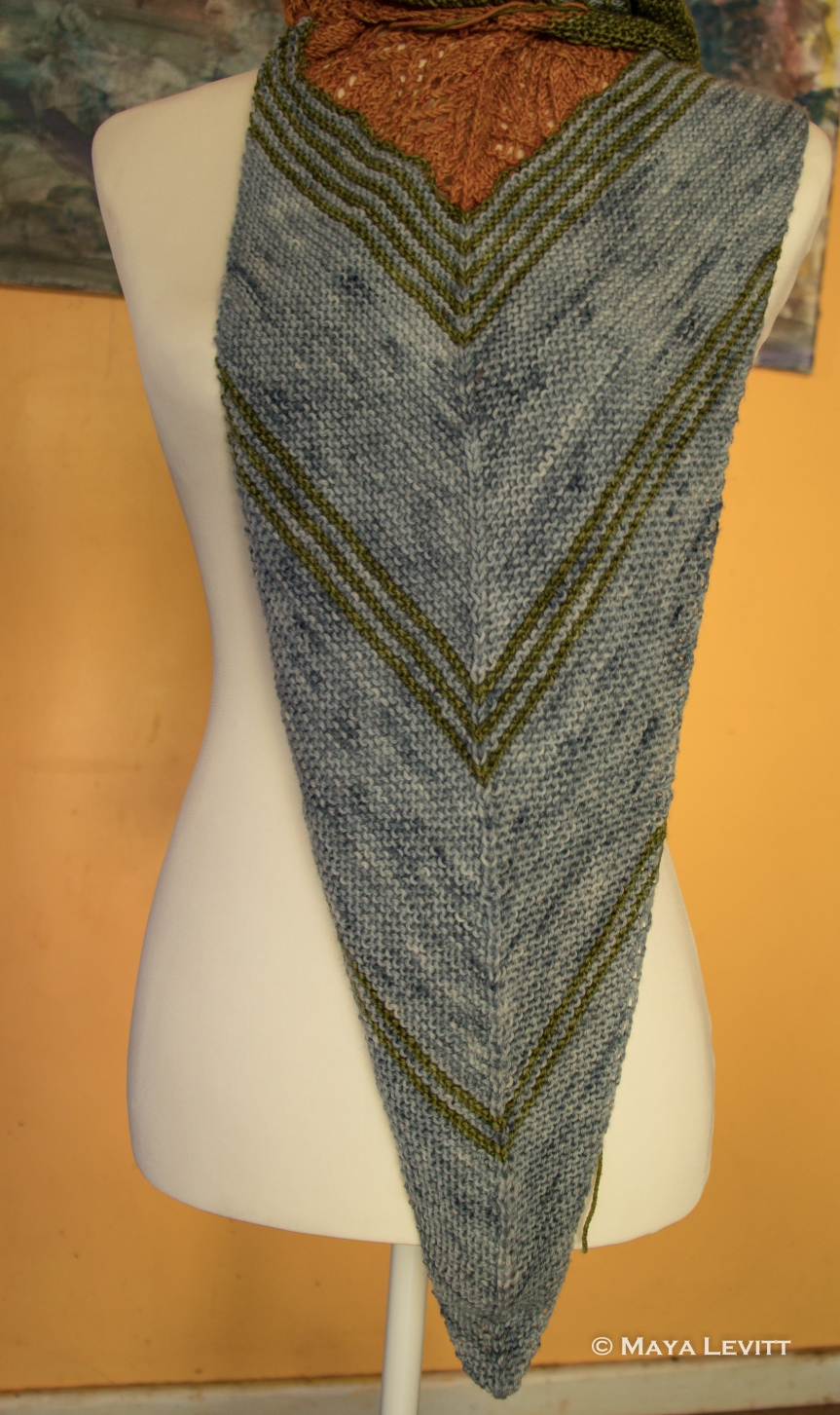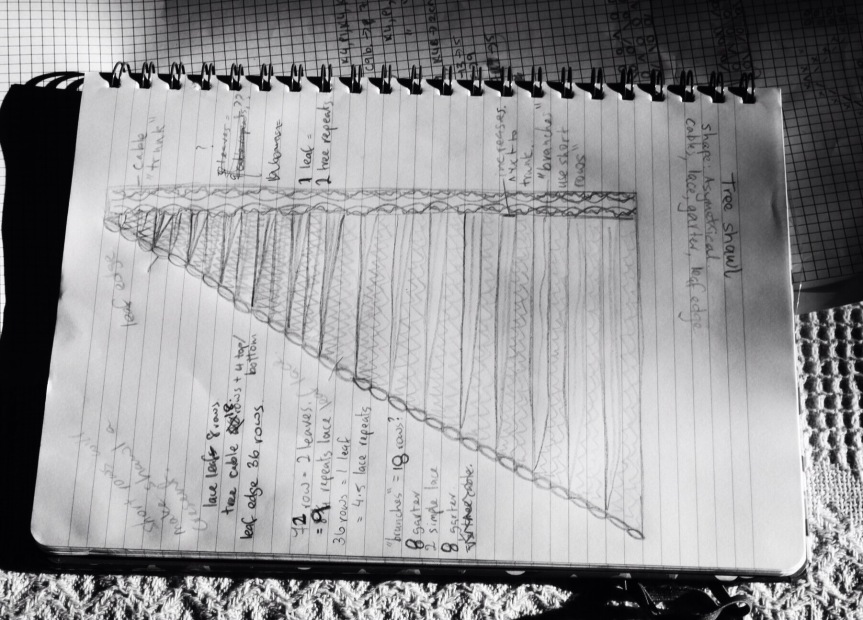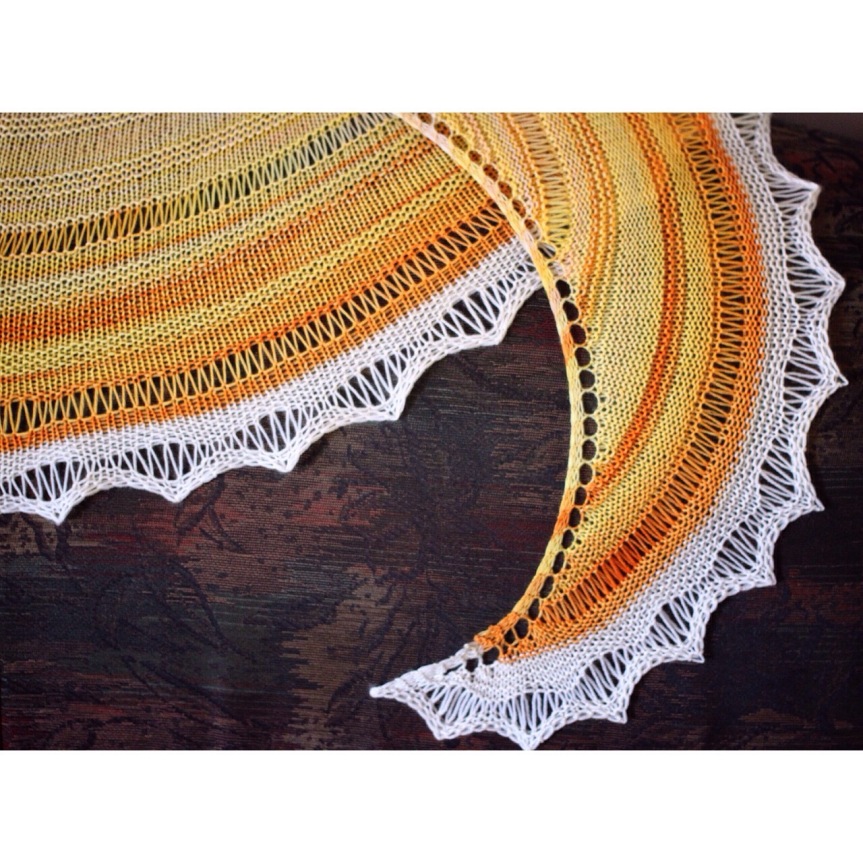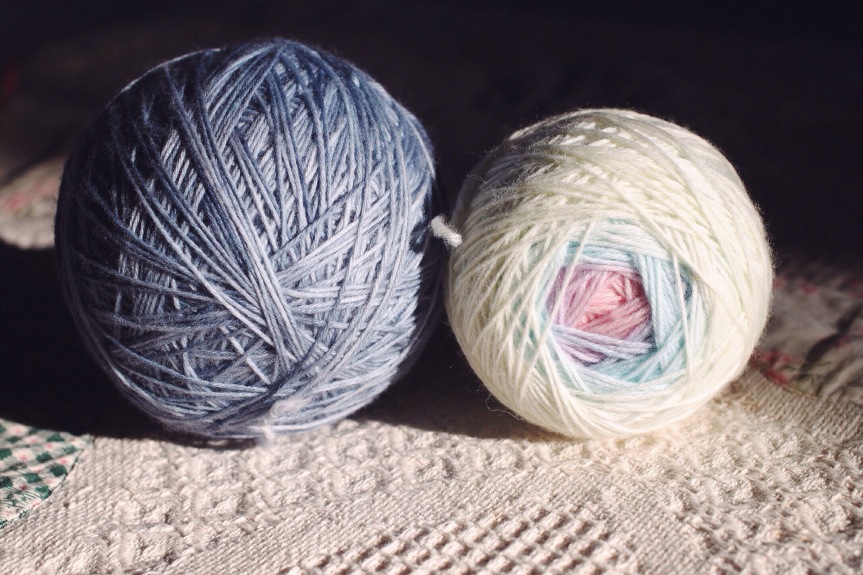Here it is, Friday again.
Today we tackle the first lace section. I have provided both written and charted instructions for this section. If you have any questions please email me or comment on Instagram.
Written Instructions
Change to Colour C
Row 1 (RS): Kfb, k, *p, ssk, yo, ssk, k, m1r, k, m1l, k, k2tog, yo, k2tog ; work from * 6 times, p, k, cdd, k, p, ssk, yo, ssk, k, m1r, k, *m1l, k, k2tog, yo, k2tog, p, ssk, yo, ssk, k, m1r, k ; work from * twice, k2, kfb, k. (115 sts)
Row 2 (and every other WS row): K2, purl the purl stitches and knit the knit stitches until 2 stitches from the end. Kfb, k1. (116 sts)
Row 3: Kfb, k3, *p, ssk, yo, ssk, k, m1r, k, m1l, k, k2tog, yo, k2tog ; work from * 6 times, p, cdd, p, ssk, yo, ssk, k, m1r, k, *m1l, k, k2tog, yo, k2tog, p, ssk, yo, ssk, k, m1r, k ; work from * twice, k3, kfb, k. (116 sts)
Row 5: Kfb, k3, yo, k2tog, *p, ssk, yo, ssk, k, m1r, k, m1l, k, k2tog, yo, k2tog ; work from * 6 times, cdd, ssk, yo, ssk, k, m1r, k, *m1l, k, k2tog, yo, k2tog, p, ssk, yo, ssk, k, m1r, k ; work from * twice, m1l, k, k2tog, k, kfb, k. (117 sts)
Row 7: Kfb, k2, (k, k2tog, yo, k2tog), yo, *k, (yo, ssk) x 2, k3, k2tog, yo, k, cdd ; work from * 6 times, k, yo, ssk, k2, *k, (k2tog, yo) x 2, k, (yo, ssk) x 2, k2 ; work from * twice, k, k2tog, yo, k2, kfb, k. (118 sts)
Row 9: Kfb, k, yo, ssk, k, *k2tog, yo, k, yo, k3, (yo, ssk) x 2, k ; work from * 6 times, k2tog, yo, k, cdd, k, yo, ssk, k, *(k2tog, yo) x 2, k3, (yo, ssk) x 2, k ; work from * twice, (k2tog, yo) x 2, k2, kfb, k. (119 sts)
Row 11: Kfb, k4, yo, sl1, k2tog, psso, *(yo, k2tog) x 2, yo, k, (yo, ssk) x 2, yo, sl1, k2tog, psso ; work from * 6 times, yo, k, cdd, k, yo, sl1, k2tog, psso, *(yo, k2tog) x 2, yo, k, (yo, ssk) x 2, yo, sl1, k2tog, psso ; work from * twice, (yo, k2tog) x 2, yo, k2, kfb, k. (120 sts)
Row 13: Kfb, k3, (yo, ssk) x 2, k, *(k2tog, yo) x 2, k3, (yo, ssk) x 2, k ; work from * 6 times, k, cdd, k2, (k2tog, yo) x 2, k2, *k, (yo, ssk) x 2, k, (k2tog, yo) x 2, k2 ; work from * twice, k2, kfb, k. (121 sts)
Row 15: Kfb, k3, (k3, yo, ssk, yo, sl1, k2tog, psso), *yo, k2tog, yo, k5, (yo, ssk) x 2 ; work from * 6 times, cdd, (k2tog, yo) x 2, k3, *k2, yo, ssk, yo, sl1, k2tog, psso, yo, k2tog, yo, k3 ; work from * twice, k3, kfb, k. (122 sts)
Row 17: Kfb, k, yo, k2tog, k, m1r, *k, m1l, k, ssk, yo, ssk, p, k, yo, k2tog, k, m1r ; work from * 6 times, k, m1l, k, ssk, yo, ssk, cdd, k2, k2tog, k, m1r, k, *m1l, k, ssk, yo, ssk, p, ssk, yo, k2tog, k, m1r, k ; work from * twice, m1l, k3, kfb, k. (123 sts)
Row 19: Kfb, k, p, k, yo, ssk, k, m1r, *k, m1l, k, k2tog, yo, k2tog, p, k, yo, ssk, k, m1r ; work from * 6 times, k, m1l, k, k2tog, k, cdd, k, ssk, k, m1r, k, *m1l, k, k2tog, yo, k2tog, p, ssk, yo, ssk, k, m1r, k ; work from * twice, m1l, k, k2tog, yo, k2tog, kfb, k. (124 sts)
Row 21: Kfb, k3, p, k, yo, ssk, k, m1r, *k, m1l, k, k2tog, yo, k2tog, p, k, yo, ssk, k, m1r ; work from * 6 times, k, m1l, k2, cdd, ssk, k, m1r, k, *m1l, k, k2tog, yo, k2tog, p, ssk, yo, ssk, k, m1r, k ; work from * twice, m1l, k, k2tog, yo, k2tog, p, kfb, k. (125 sts)
Row 23: Kfb, k, (k2tog, yo) x 2, k, (yo, ssk) x 2, k, *k2, (k2tog, yo) x 2, k, (yo, ssk) x 2, k ; work from * 6 times, k3, cdd, k3, *k, (k2tog, yo) x 2, k, (yo, ssk) x 2, k2 ; work from * twice, k, (k2tog, yo) x 2, k2, kfb, k. (126 sts)
Row 25: Kfb, k2, (k2tog, yo) x 2, k2, *k, (yo, ssk) x 2, k, (k2tog, yo) x 2, k2 ; work from * 6 times, k, (yo, ssk) x 2, k2, cdd, k2, *(k2tog, yo) x 2, k3, (yo, ssk) x 2, k ; work from * twice, (k2tog, yo) x 2, k4, kfb, k. (127 sts)
Row 27: Kfb, k3, (k2tog, yo) x 3, k, *(yo, ssk) x 2, yo, sl1, k2tog, psso, (yo, k2tog) x 2, yo, k ; work from * 6 times, (yo, ssk) x 2, yo, k, cdd, k2tog, *(yo, k2tog) x 2, yo, k, (yo, ssk) x 2, yo, sl1, k2tog, psso ; work from * twice, (yo, k2tog) x 2, yo, k, yo, ssk, k, kfb, k. (128 sts)
Row 29: Kfb, k, (yo, ssk) x 2, k, (k2tog, yo) x 2, k2, *k, (yo, ssk) x 2, k, (k2tog, yo) x 2, k2 ; work from * 6 times, k, (yo, ssk) x 2, cdd, (k2tog, yo) x 2, k3, yo, ssk, *yo, ssk, k, (k2tog, yo) x 2, k3, yo, ssk ; work from * twice, k, kfb, k. (129 sts)
Row 31: Kfb, k4, yo, ssk, yo, sl1, k2tog, psso, yo, k2tog, yo, k3, *k2, yo, ssk, yo, sl1, k2tog, psso, yo, k2tog, yo, k3 ; work from * 6 times, k2, yo, ssk, cdd, k2tog, yo, k5, yo, *ssk, yo, sl1, k2tog, psso, yo, k2tog, yo, k5, yo ; work from * twice, ssk, k, kfb, k. (130 sts)
Row 33: Kfb, k4, m1l, k, ssk, yo, ssk, p, k2tog, yo, k2tog, k, m1r, k, *m1l, k, ssk, yo, ssk, p, k2tog, yo, k2tog, k, m1r, k ; work from * 6 times, m1l, k, ssk, cdd, k2tog, k, m1r, k, m1l, k, ssk, *yo, ssk, p, k, yo, k2tog, k, m1r, k, m1l, k, ssk ; work from * twice, yo, ssk, p, kfb, k. (131 sts)
Row 35: Kfb, k2, ssk, k, m1r, k, m1l, k, k2tog, yo, k2tog, p, ssk, yo, ssk, k, m1r, k, *m1l, k, k2tog, yo, k2tog, p, ssk, yo, ssk, k, m1r, k ; work from * 6 times, k2, cdd, k3, m1l, k, k2tog, *yo, k2tog, p, ssk, yo, ssk, k, m1r, k, m1l, k, k2tog ; work from * twice, yo, k2tog, p, k, kfb, k. (132 sts)
Row 37: Kfb, k, p, ssk, yo, ssk, k, m1r, k, m1l, k, k2tog, yo, k2tog, p, ssk, yo, ssk, k, m1r, k, *m1l, k, k2tog, yo, k2tog, p, ssk, yo, ssk, k, m1r, k ; work from * 6 times, k, cdd, k2, m1l, k, k2tog, *yo, k2tog, p, ssk, yo, ssk, k, m1r, k, m1l, k, k2tog ; work from * twice, yo, k2tog, p, k2, kfb, k. (133 sts)
Row 39: Kfb, k, k2tog, yo, k, (yo, ssk) x 2, k3, (k2tog, yo) x 2, k, *(yo, ssk) x 2, k3, (k2tog, yo) x 2, k ; work from * 6 times, (yo, ssk) x 2, k2, cdd, k2, k2tog, yo, *k2tog, yo, k, (yo, ssk) x 2, k3, k2tog, yo ; work from * twice, k2tog, yo, k, yo, ssk, k, kfb, k. (134 sts)
Row 41: Kfb, k2, k2tog, yo, k3, (yo, ssk) x 2, k, (k2tog, yo) x 2, k2, *k, (yo, ssk) x 2, k, (k2tog, yo) x 2, k2 ; work from * 6 times, k, (yo, ssk) x 2, cdd, k2tog, yo, k2tog, *yo, k3, (yo, ssk) x 2, k, k2tog, yo, k2tog ; work from * twice, yo, k3, yo, ssk, k, kfb, k. (135 sts)
Row 43: Kfb, k3, (k2tog, yo) x 2, k, (yo, ssk) x 2, yo, k, (yo, k2tog) x 2, yo, k, *(yo, ssk) x 2, yo, sl1, k2tog, psso, (yo, k2tog) x 2, yo, k ; work from * 6 times, (yo, ssk) x 2, cdd, k2tog, yo, *k2tog, yo, k, (yo, ssk) x 2, yo, sl1, k2tog, psso, yo, k2tog, yo ; work from * twice, k2tog, yo, k, (yo, ssk) x 2, k, kfb, k. (136 sts)
Row 45: Kfb, k, yo, ssk, k, (k2tog, yo) x 2, k3, (yo, ssk) x 2, k, (k2tog, yo) x 2, k2, *k, (yo, ssk) x 2, k, (k2tog, yo) x 2, k2 ; work from * 6 times, k, yo, ssk, cdd, k2tog, *yo, k3, (yo, ssk) x 2, k, k2tog, yo, k2tog ; work from * twice, yo, k3, (yo, ssk) x 2, k, kfb, k. (137 sts)
Row 47: Kfb, k4, yo, sl1, k2tog, psso, yo, k2tog, yo, k5, yo, ssk, yo, k, yo, k2tog, yo, k3, *k2, yo, ssk, yo, sl1, k2tog, psso, yo, k2tog, yo, k3 ; work from * 6 times, k2, cdd, *k5, yo, ssk, yo, sl1, k2tog, psso, yo, k2tog, yo ; work from * twice, k5, (yo, ssk) x 2, k, kfb, k. (138 sts)






